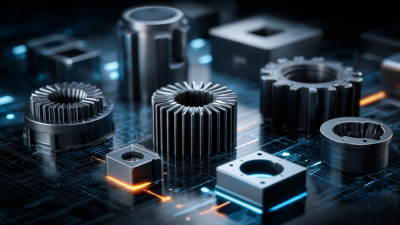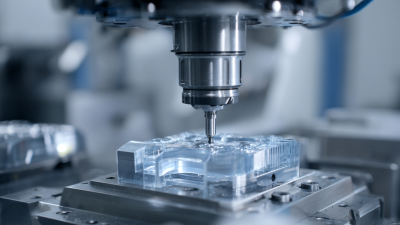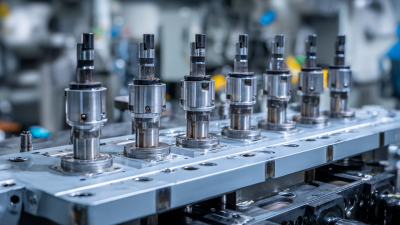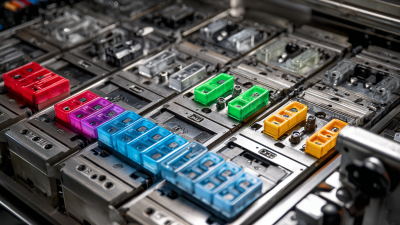
Creative Examples of Successful Injection Molding Applications Across Industries
The injection molding industry plays a pivotal role in the manufacturing landscape, with a market size projected to reach $375 billion by 2025, according to a report by Grand View Research. As businesses continuously seek innovative solutions to optimize production efficiency and reduce costs, the versatility of injection molding has gained unprecedented recognition across various sectors, from automotive and healthcare to consumer products. This process not only allows for the mass production of parts with complex geometries but also facilitates the use of sustainable materials, catering to the growing demand for eco-friendly manufacturing practices. In this blog, we will explore creative examples of successful injection molding applications that highlight its transformative impact on diverse industries, showcasing how this technology is shaping the future of production and design.

Creative Injection Molding Applications in Automotive: Enhancing Performance and Safety
In the rapidly evolving automotive industry, creative injection molding applications are enhancing both performance and safety. By leveraging advanced materials and manufacturing techniques, automotive manufacturers are able to produce components that not only meet stringent safety standards but also contribute to overall vehicle efficiency. One notable trend is the integration of hybrid systems through a one-step manufacturing process that combines forming and bonding. This method streamlines production while improving the strength and durability of automotive parts, making them lighter and more resilient.
The surge in electric vehicle production has further propelled innovation in injection molding. As the industry shifts towards sustainable practices, manufacturers are exploring new opportunities to create components that cater to the growing demand for eco-friendly vehicles. This includes utilizing materials that reduce weight and improve energy efficiency, while ensuring that safety remains a paramount concern. Consequently, as the automotive market continues to expand, we can expect injection molding to play a vital role in shaping the future of vehicle design, focusing on enhanced performance and unmatched safety features.
Innovative Uses of Injection Molding in Healthcare: Efficient Solutions for Medical Devices
Injection molding has transformed the healthcare sector by providing efficient and precise solutions for medical device manufacturing. According to a report by Market Research Future, the global medical injection molding market is projected to reach $4.4 billion by 2025, growing at a CAGR of 6.5%. This growth is fueled by the increasing demand for sophisticated medical devices that require high accuracy and consistency in production.
One notable application of injection molding in healthcare is the production of custom surgical instruments and implants. These devices must meet stringent regulatory standards and be manufactured to precise specifications, which injection molding excels at providing. For instance, the use of biocompatible polymers in injection molding allows for the safe and effective production of devices that can withstand sterile conditions, ultimately improving patient outcomes. A study conducted by the University of California revealed that using injection molding for orthopedic implants reduced production time by 30% while maintaining high quality.
Moreover, the rise of single-use medical devices has further propelled the injection molding market. As hospitals seek to enhance hygiene and reduce cross-contamination risks, disposable devices made through injection molding become an attractive solution. The dense production capability of injection molding ensures that high volumes of single-use items can be manufactured swiftly without compromising on quality, thus meeting the industry's growing needs efficiently.
Creative Examples of Successful Injection Molding Applications Across Industries - Innovative Uses of Injection Molding in Healthcare: Efficient Solutions for Medical Devices
| Application Area | Description | Material Used | Advantages |
|---|---|---|---|
| Syringe Bodies | Manufactured for ease of use in vaccinations and medicine delivery. | Polypropylene (PP) | Low cost, high clarity, and excellent chemical resistance. |
| Orthopedic Implants | Customized to fit the patient's anatomical structure. | Medical-grade Titanium | High strength and biocompatibility. |
| Blood Testing Devices | Used for quick analysis of blood samples. | Polycarbonate (PC) | Durable, transparent, and impact-resistant. |
| Dental Tools | Instruments manufactured for precision oral care. | Acrylonitrile Butadiene Styrene (ABS) | Excellent toughness and surface finish. |
| Infusion Pumps | Devices designed to deliver fluids, medication, or nutrients. | Polyvinyl Chloride (PVC) | Flexible and resistant to chemical degradation. |
Sustainable Practices: Injection Molding's Role in Eco-Friendly Packaging Solutions
As the demand for sustainable packaging solutions grows, the injection molding industry is stepping up to provide eco-friendly alternatives that minimize environmental impact. Recent studies indicate that over 30% of packaging materials are derived from recycled sources, with injection molding playing a central role in this shift. By utilizing biodegradable plastics and recycled materials, companies can significantly reduce waste and promote a circular economy. For instance, using post-consumer recycled (PCR) plastic not only decreases the reliance on virgin materials but can cut carbon emissions by up to 50%, according to the Environmental Protection Agency (EPA).
To further enhance sustainability in injection molding practices, companies should consider these tips: First, prioritize the use of bioplastics that decompose more quickly than traditional plastics, thus reducing landfill contributions. Second, implement energy-efficient processes in manufacturing to lessen the overall carbon footprint and facilitate cost savings. Lastly, focus on designing packaging that not only meets functional needs but is also easy to recycle, which encourages consumers to participate in recycling programs actively.
The innovation in injection molding is paving the way for a greener future. By adapting these sustainable practices, industries can contribute to environmental preservation while meeting consumer expectations for eco-conscious products.
Consumer Electronics: Revolutionizing Product Design Through Injection Molding Techniques
Injection molding has become a cornerstone of product design in the consumer electronics industry, enabling the creation of innovative, lightweight, and durable products. With its ability to produce complex geometries at scale, manufacturers can experiment with intricate designs that were previously impractical or impossible. For instance, brands are now able to create ergonomically designed devices that fit seamlessly into users' lifestyles, making technology more accessible and intuitive.

The versatility of injection molding allows for the use of various materials, tailoring products to meet specific performance requirements. This adaptability has transformed how consumer electronics are designed, focusing not only on aesthetics but also on functionality.
Take smartphone casings, for example; they are crafted using advanced molding techniques that not only enhance their visual appeal but also ensure sturdiness and durability. Additionally, color options and surface finishes can be combined during the molding process, eliminating the need for additional painting or coatings, thus reducing production time and costs. This synergy of form and function illustrates how injection molding techniques are driving a revolution in product design within the consumer electronics sector.
Injection Molding in Aerospace: Achieving Precision and Reducing Weight with Advanced Materials
The aerospace industry has long been at the forefront of innovation, leveraging advanced materials and manufacturing techniques to enhance performance and efficiency. Injection molding, a process that allows for the high-volume production of complex shapes, has emerged as a game-changer in this field. According to a recent market report by ResearchAndMarkets, the global aerospace injection molding market is projected to grow from $1.39 billion in 2021 to $2.16 billion by 2026, at a CAGR of 9.1%. This growth is driven by the industry’s need for precision-engineered components that not only fulfill stringent safety standards but also contribute to weight reduction goals.

One of the most compelling examples of injection molding in aerospace is the use of advanced lightweight materials such as thermoplastics and composites. These materials enable manufacturers to create parts that are both strong and lightweight, significantly impacting fuel efficiency and reducing emissions. For instance, Boeing has reported that their use of injection-molded components in aircraft design has led to weight reductions of up to 15%. This not only translates into cost savings over the lifetime of the aircraft but also aligns with the industry's increasing emphasis on sustainability. As the demand for more efficient flight solutions rises, injection molding remains a key technique in developing the next generation of aerospace components.
Related Posts
-

Exploring the Benefits and Applications of Various Injection Molding Products in Today's Industry
-

Quality Driven Global Success of Prototype Injection Molding from China
-

5 Key Benefits of Investing in Injection Tooling for Global Buyers
-

Understanding Characteristics and Applications of Best Injection Molding Tooling Variants
